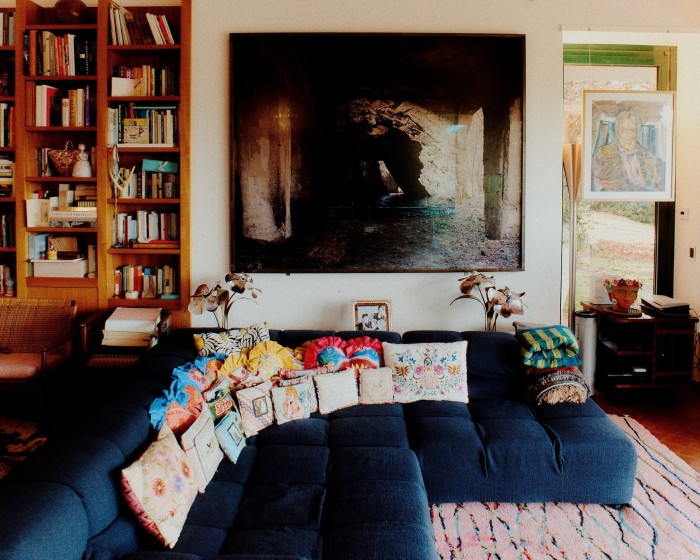‘Admit failure and you are free to start over’

Margherita Maccapani Missoni’s former self would probably view her current life, including her new home in Varese — known as Lombardy’s garden city — with bemusement.
The designer moved into the 1970s villa over the summer after selling the much larger mansion she and her racing-car driver ex-husband had built. It follows her abrupt and somewhat dramatic exit from Missoni, her family’s eponymous fashion house, three years ago, the end of her marriage and the launch of her own Maccapani ready-to-wear label (backed by former Gucci chief executive Marco Bizzarri), whose bestseller is a T-shirt with a wilted daisy — margherita in Italian — printed on it.
“Margherita is a flower which is forced to always be happy,” says Maccapani Missoni. “But here we have a Margherita who has lived and thrived and is now able to show herself for what she is — which isn’t necessarily always happy.” She is sitting on a large dark blue sofa — scattered with small cushions, including a few made from old washcloths from when she was a baby — that she originally bought for her New York apartment 20 years ago.
At 41, she says she has no nostalgia for her past. “Three years ago I thought I had accomplished my life goals. Then it all came apart. I would never have imagined I would have an entirely different life,” she says. She describes her present as “authentic and expectation free”.

Her new house, which also takes in the Maccapani offices and the Missoni family’s fashion archives on the lower ground floor, is a testament to both her personal evolution and her heritage.
The living space is spread across a single floor; the 500 sq m villa features tall sloped ceilings, terracotta floors, glass walls and a bold mix of coloured tiles. It overlooks a large garden, today carpeted in autumn leaves, and pool. It bears little resemblance to her previous bright, multicoloured, high-design home. Nevertheless, the Missoni aesthetic — patterns, vintage finds and bold pieces — is a strong presence.
The retro style of the house — including details Maccapani Missoni defines as “challenging”, such as the bright ochre tiles in the master bathroom and the “masculine” grey stone partitions in the living room — was inspiration for the interiors scheme. For it, she adapted some of the made-to-measure pieces from her previous home, sifted through her mother Angela Missoni’s furniture catalogues, and foraged in the basement of her 93-year-old nonna Rosita Missoni. “I didn’t buy anything new,” she says. “I like the concept of upcycling, I tend to work better when my tools are limited.”


The concept of mixing and matching old and new is also an important feature of Maccapani Missoni’s professional life. She recently struck a partnership with ecommerce platform eBay, through which she sells Maccapani designs and vintage pieces from the Missoni archive. A second-hand ethos, she says, represents a significant part of “my lifestyle, the way I dress and my aesthetic.” In her new designs, Maccapani Missoni experiments with materials, as well as bold, youth culture-inspired cuts: a hooded waistcoat has been a hit in the Middle East.
Growing up in the nearby town of Sumirago, in the foothills of the Alps — where Rosita and her late husband Ottavio founded the label in 1953 and where its factories are still located — Maccapani Missoni says she would spend “entire weekends at local flea markets” with her mother, sister and grandmother. The mercatini were a constant source of creative inspiration for the women professionally.

Evidence of this penchant for collecting is visible throughout her home. The aesthetic is eclectic: a painting by Scottish artist Caroline Walker hangs beside her children’s drawings on the dining room walls. It’s a style that, she says, tells “the story of her life” and is “very much linked to emotions and influences. It starts with a passion, and it becomes a mixture of the things you are exposed to: the flea markets, the art shows, the designs. At Missoni, my family turned that into fashion,” she says.
For more than a decade, Maccapani Missoni was the face of the brand. From 2018 — when Italy’s Fondo Strategico Italiano fund took a 41 per cent stake in the company — to 2021, she also became the creative director of M Missoni, the label’s second prêt-à-porter line. When finances during the pandemic forced the group to restructure, her fashion line was axed and she left the company.
“I was a person but also a role, and that somehow overlapped in people’s minds, including my family’s,” she says. “It was hard to tell the difference between me and my job. Missoni has this colourful, cheerful and very family-oriented image, which was essentially what I had to represent,” she continues. “The idea that I and everything about me had to be perfect is something I ultimately let go of.”


She spent the first few months in her new home sleeping on a cardboard bed as she waited for a new frame — carved from a Lebanese cedar tree from her old garden that had to be felled — to be made. Her bedroom wall now features a bright red and blue heart-shaped neon sign given to her by her boyfriend, Marcantonio Brandolini d’Adda — the chief executive and art director of Laguna B, a Venetian glassware brand.
In the bathroom, she has managed to take the edge off the retro ochre tiles by commissioning an artist who spray paints racing drivers’ helmets to paint an old wood cabinet in white and fuchsia.
She decided not to make any significant architectural interventions to the house before moving in, uncertain as to how long she and her two children, aged 11 and 9, might live there in the wake of the numerous changes taking place in their lives. She also confesses that she is tempted to move to Milan, a one-hour drive south. It’s where the Maccapani brand’s second office is located and where she is searching for a physical store for the company.

Until now, aside from the five years she spent in New York, where she worked for Missoni and studied acting, Maccapani Missoni has always been convinced she would live in Varese.
“Growing up, I dreamt of city lights, which is why I moved to New York. At the time, in the early 2000s, Missoni was experiencing a renaissance under my mother’s creative direction. It was the time of [supermodel] Gisele Bündchen’s first Missoni campaigns for [photographers] Mert and Marcus,” she says. “It was explosive. My mother and grandmother didn’t travel much, so I went instead . . . the Oscars, the Cannes film festival, the Met Gala.”
But as she became more involved with the brand, she realised she would eventually have to return home to Varese. “I didn’t think I had an option. My mother and her siblings and their children had been encouraged to work for the family company. I didn’t want to let my nonna down,” she says.

Recently events have changed her perspective. “I had to deal with failure, because one way or another that’s what it was. But once you admit you’ve failed you are free to start over,” she says. “Without being perfect.”
This sense of acceptance and embracing imperfections is what underscores her approach to her new home. “There’s nothing really Missoni in here aside from the Margherita armchairs in Missoni fabric. But at the end of the day [mine is] a Missoni world; every object has a story. I haven’t erased my past; it’s all about my heritage, my experiences, my life.”
Silvia Sciorilli Borrelli is the FT’s Milan correspondent
Find out about our latest stories first — follow @ft_houseandhome on Instagram
#Admit #failure #free #start




